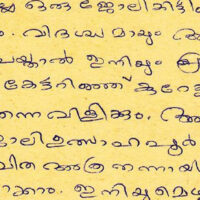All writing systems in India are based on the Brahmi script, the first evidence of which is the group of inscriptions by King Ashoka in the third century BCE. Malayalam has been written in several scripts, including Brahmi, Vatteluttu, Grantha, and modern Malayalam scripts beginning in roughly the ninth century CE.
For English speakers, the Malayalam writing system, or script, may look intimidating. It’s not really. It works a little differently and requires some memorization, but the script is phonetic, meaning that you say it as you write it (mostly!), and syllabic, meaning that it’s based on an alphabet and the syllables you can make with an alphabet. With some hard work, you can learn the script within a week and never look back.
There are four types of letters or syllables in Malayalam: initial vowels, consonants, dependent vowels added to consonants, and combining consonants for conjunct sounds. That means there are three tricky parts about learning the Malayalam script for English readers. 1) If a vowel begins a word, you must use its initial vowel form. When a vowel occurs in the middle of a word, you must use its dependent vowel form. 2) Consonants always have an inherent a-sound, unless they are marked with a different dependent vowel or “cut off” with the special sign that looks like small crescent, for example ത് ല്, or other marker. 3) For some clusters of consonants (str, pl, kr, ty, etc.) you will have to recognize and use a few special combining consonant forms. This guide covers the modern or reformed Malayalam script, established in the 1970s to facilitate typing and computer entry.
Let’s learn the initial vowels first. The chart below is also the alphabetical order for Malayalam vowels. Rounded letters are characteristic of most South Indian language scripts and you will gradually get used to writing with lots of curves. The Roman letter equivalents indicate that most vowels have both a short and a long version. Click each letter below to see a clip showing how each should be written by hand.















Next we come to the consonants. The full chart of consonants (also in alphabetical order) below is organized according to where in the mouth a letter is pronounced (from back to front in the rows) and the addition of aspiration, voicing, or nasalization (from left to right in the columns). Please consult the pronunciation guides for details. For now, first study the chart below to get an overview of all the consonants. Remember that all consonants have an inherent a-sound (short a) without any additional marker. Next, see how each consonant is formed in handwriting by clicking each. All the basic consonants should be formed in a single sequence of curved movements, i.e. your pen should not leave the paper—one complex motion.




































To put consonants and vowels together, you need to use dependent vowels. To change the inherent a-sound of a consonant, you add a dependent vowel marker to indicate the new vowel. In the modern Malayalam script described here, all these markers stand apart from the consonant, usually to the right side of the consonant but sometimes on both sides (for ഒ ഓ ഐ and ഔ). (In the old script, some dependent vowels were joined directly to the consonant.)
Initial | Dependent | Initial | Dependent | Initial | Dependent |
|---|---|---|---|---|---|
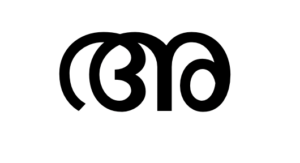 | 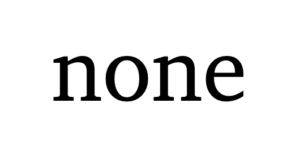 | 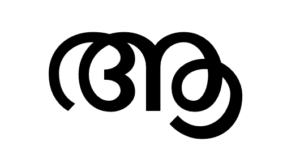 |  | ||
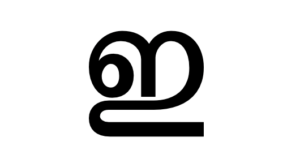 |  | 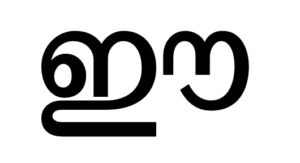 |  | ||
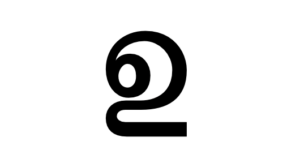 |  | 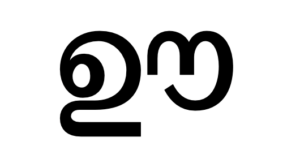 | 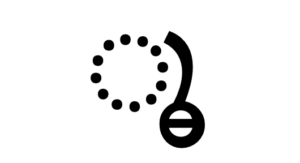 |  | 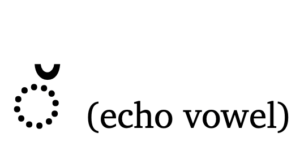 |
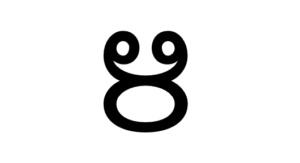 |  | 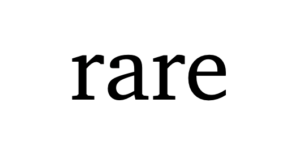 |  | ||
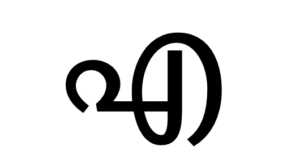 |  | 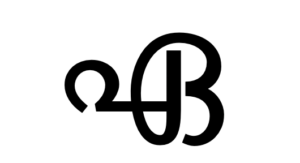 | 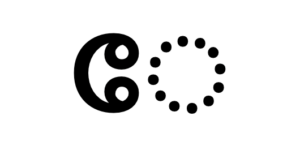 | 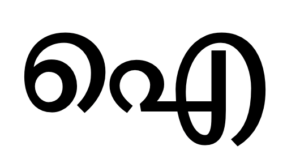 | 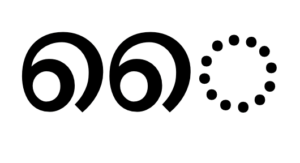 |
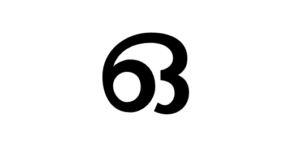 | 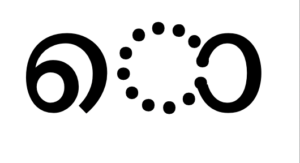 | 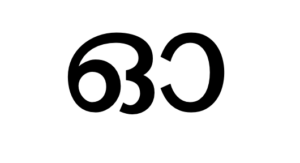 | 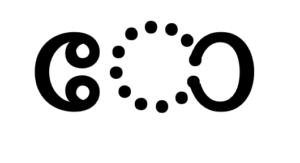 | 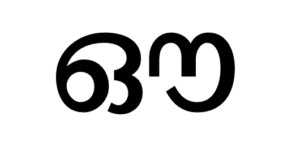 | 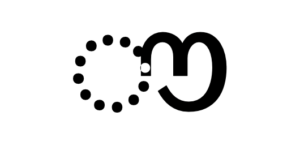 |
See below how each dependent vowel connects to the letter ക:

The same dependent vowel markers are used with all basic consonants and the consonant clusters described below. The best way to learn the Malayalam script is to write all the basic consonants with all the dependent vowels over and over again. Try to write each group in a single line on the page. Something like this:
ക കാ കി കീ കു കൂ കൃ കെ കേ കൈ കൊ കോ കൗ
ഖ ഖാ ഖി ഖീ ഖു ഖൂ ഖൃ ഖെ ഖേ ഖൈ ഖൊ ഖോ ഖൗ
ഗ ഗാ ഗി ഗീ ഗു ഗൂ ഗൃ ഗെ ഗേ ഗൈ ഗൊ ഗോ ഗൗ
Do this twice a day for a week and you will be unable to forget these letters, especially if you pronounce each one as you go. Notice that some initial vowels and several dependent vowels extend below or above the imaginary lines within which each letter is written.

Many Malayalam words end in a special type of vowel that we will call the echo vowel (also called a schwa). Think of it as a kind of half-u vowel sound, a special dependent vowel. Echo vowel has no initial form. It is indicated by a small crescent high and to the right of a basic consonant (്). At the end of a word (where it most frequently occurs), the echo vowel is just another vowel sound.
However, the modern Malayalam script also uses the same symbol to cut off the inherent final a-sound in a consonant. As a general rule of thumb, if the echo vowel is at the end of a word, you can treat it as a half-u vowel sound; if it’s in the middle of a word, it cuts off the a-sound and creates a consonant cluster. Some simple examples with transliteration should illustrate the difference.
ത് (tǔ) as in അത് (atǔ) “that one”
ട് (ṭǔ) as in നാട് (nāṭǔ) “country, region”
ത്പ (tpa) as in ഉത്പത്തി (utpatti) “origin”
ഷ്ട (ṣṭa) as in കഷ്ടം (kaṣṭaṃ) “trouble, problem”
There is another way to cut off the inherent a-sound in a consonant. In Malayalam, it’s called a cillakṣaraṃ, or cillǔ letter. For common words that end in a consonant, a line is drawn vertically to indicate that the a-sound is cut off. In principle, the echo vowel does the same thing, but in practice it’s better to treat echo vowel as a vowel. When words end with one of the following consonants, the cillǔ letter is required. They can also be used in the middle of words with the same effect. While related, therefore, the echo vowel and a cillǔ marker are not the same.
ണ → ൺ (ṇ)
ന → ൻ (n)
ര/റ → ർ (r)
ത/ല → ൽ (t/l)
ള → ൾ (ḷ)
ക → ൿ (k)
Other consonants do not have cillǔ forms. Those all use the echo vowel marker to create a final consonant, though the half-u sound is often still pronounced.
ഷ് (ṣ) as in മാഷ് (māṣ) “teacher”
ഡ് (ḍ) as in ഡേവിഡ് (ḍēviḍ) “David” (name)
സ് (s) as in മനസ്സ് (manassǔ) “mind, heart”
ങ് (ṅ) as in തെങ്ങ് (teṅṅǔ) “coconut tree”
The use of echo vowel and cillǔ letters is very common and you will pick up how to use each correctly with a little practice.
Many Malayalam words are spelled with doubled consonants, two of the same consonant written together into one syllable. Doubled consonants are written both horizontally and vertically. The second consonant in the cluster often uses a shortened form of the full consonant. Notice particularly the small triangle shape that doubles the letters ച യ and വ. Since doubled consonants occur frequently, you should get comfortable with these combining forms. Letters from the ക and ങ (nasals) columns (not rows) above frequently double; other letters may double, but more rarely. Here are the most common doubled consonants.
| ക → ക്ക | ട → ട്ട | പ → പ്പ |
| ങ → ങ്ങ | ണ → ണ്ണ | മ → മ്മ |
| ച → ച്ച | ള → ള്ള | വ → വ്വ |
| ഞ → ഞ്ഞ | ത → ത്ത | ല → ല്ല |
| യ → യ്യ | ന → ന്ന | റ → റ്റ |
Finally, many Malayalam words combine more than one consonant together into a conjunct or cluster. Usually, a conjunct combines two consonants by joining them horizontally at a common stroke or by using the echo vowel marker on the first. You shouldn’t have to memorize every possible cluster, because the methods or patterns of combining consonants are limited. Notice the patterns in some of the more common conjunct consonants:
| ക്ത | ക്ഷ | ഗ്ന | ജ്ഞ | ത്ഥ | ത്മ | ത്സ | ദ്ധ | ശ്ച | സ്ഥ |
| kta | kṣa | gna | jña | ttha | tma | tsa | ddha | śca | stha |
Some n-sounds are tricky in how they combine with other consonants.
| ങ്ക | ഞ്ച | ണ്ട | ന്ത | ന്ദ | മ്പ | ന്റ |
| ṅka | ñca | ṇṭa | nta | nda | mpa | ṉṯa |
The remaining conjunct consonants often use the echo vowel marker to make conjuncts. Traditionally, these conjuncts would have been written vertically, with the second letter below the first. You will see both.
| ക്മ | യ്ത | യ്ച്ച | സ്ന | സ്ക | ഷ്മ | ഷ്ട | ഷ്ണ | ശ്ന | സ്പ | ഴ്ച |
| kma | yta | ycca | sna | ska | ṣma | ṣṭa | ṣṇa | śna | spa | ḻca |
Finally, a few special combining consonant markers for the semivowels (യ ര/റ ല and വ) are used to make the writing less cluttered. These frequent combining forms are simplified or stylized versions of the regular consonant. These are the dependent semivowels.
ത് + യ = ത്യ
വ് + ര = പ്ര
പ് + ല = പ്ല
സ് + വ = സ്വ
Once you have mastered the basic consonants and common conjuncts above, you will easily recognize other conjuncts that occur.
Here are a few of the most common mistakes made by people learning to read and write Malayalam.
- Be careful with the dependent versions of ഇ and ഈ below when handwriting. Unless they are clearly written higher than the top of the consonant, they can be confused with the dependent ആ marker. Example: പി vs. പാ.
- The letters പ and വ can be confused. Make sure the initial stroke in പ is small, less than halfway up the final vertical stroke. The top of the initial curved stroke in വ should be even with the top of the final vertical stroke.
- The letters സ and ഡ can be confused, because they are mirrored inversions of each other.
- The dependent vowel ൃ (from initial ഋ) can easily be confused with the dependent semivowel marker for യ. Remember to close the final curve on the bottom of dependent ഋ. Example: തൃ vs. ത്യ.
- The core of all letters should be the same height (between two imaginary parallel lines as shown above), but some elements must extend above or below the line as follows:
- the lower elements of the initial vowels ā, i, ī, u, ū, e, ē, and ai should extend below the line; examples: ഇ ആ ഉ ഏ.
- the dependent u, ū and ṛ vowel markers ( ു ൂ and ൃ) and all the dependent semivowels (യ ര ല and വ from the previous section) should extend below the line; examples: വു സൂ കൃ വ്യോ ഗ്രു ശ്ലോ and ശ്വ.
- the dependent i, ī, and echo vowel markers should be clearly written above the line: ി ീ and ്; examples: പ്രി ടീ ത്.
- the cillǔ marker should extend above the line. examples: ൻ ൾ.
To put all these syllables together, you simply write each letter/syllable one after the other to form words, left to right.
മ + ക + ൻ = മകൻ “son”
പ + ട്ടി = പട്ടി “dog”
പോ + കാ + ം = പോകാം “let’s go”
In general, to write a Malayalam sentence you just put words together with a space in between each word. However, you will quickly see that Malayalam, like many Indic languages, often makes use of sandhi, joining words together in a composite written form and even sometimes modifying a word’s spelling to make it easier to say—something like the contraction from “cannot” to “can’t” or from “what do you” to “whadya” / “whaccha.” These contractions or joinings occur much more frequently than in English. Unfortunately, they are also not applied consistently in all written Malayalam. For now, we give some simple sentences with each word spaced and some very simple examples of sandhi.
With spaces
ഞാൻ വീട്ടിൽ പോകുന്നു. “I am going home.”
വെള്ളം തരൂ. “Please give me some water.”
എനിക്ക് പഠിക്കാൻ വയ്യ. “I don’t feel like studying.”
ചെച്ചി എവിടെ പോയി? “Where did elder sister go?”With simple sandhi
അത് ആണ്. → അതാണ്. “That’s it.” (consonant-vowel)
നിങ്ങൾക്ക് ഉണ്ടോ? → നിങ്ങൾക്കുണ്ടോ? “Do you have it/any?” (consonant-vowel)
അനിയത്തി എടുത്തു? → അനിയത്തിയെടുത്തു. “Younger sister took it.” (vowel-vowel)
